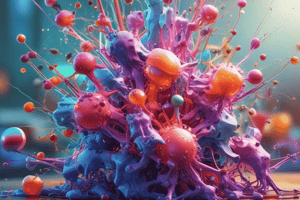Podcast
Questions and Answers
What is the primary relationship studied in electrochemistry?
What is the primary relationship studied in electrochemistry?
- The relationship between temperature and pressure
- The relationship between gases and liquids
- The relationship between electricity and chemical reactions (correct)
- The relationship between light and matter
Which concept involves the transfer of electrons between reactants?
Which concept involves the transfer of electrons between reactants?
- Reaction quotient
- Le Chatelier's principle
- Redox reactions (correct)
- Equilibrium constant
What type of devices convert chemical energy into electrical energy?
What type of devices convert chemical energy into electrical energy?
- Electrolysis cells
- Galvanic cells (correct)
- Nernst equations
- Half-reactions
Which principle guides how a system at equilibrium responds to changes in concentration, temperature, or pressure?
Which principle guides how a system at equilibrium responds to changes in concentration, temperature, or pressure?
What remains constant at a given temperature in a system at equilibrium?
What remains constant at a given temperature in a system at equilibrium?
What does chemical kinetics primarily study?
What does chemical kinetics primarily study?
Which factor does NOT influence the speed of chemical reactions according to chemical kinetics?
Which factor does NOT influence the speed of chemical reactions according to chemical kinetics?
What is the rate law in chemical kinetics used for?
What is the rate law in chemical kinetics used for?
Which concept in chemical kinetics describes the sequence of elementary steps in a chemical reaction?
Which concept in chemical kinetics describes the sequence of elementary steps in a chemical reaction?
How do collision theory and reaction rates relate in chemical kinetics?
How do collision theory and reaction rates relate in chemical kinetics?
Study Notes
Physical Chemistry: Exploring Molecular Motion and Transformations
Physical chemistry is a branch of science that investigates the behavior of matter at the atomic and molecular levels, particularly focusing on the quantitative relationships between physical properties and chemical processes. This field encompasses three fundamental subdisciplines: chemical kinetics, electrochemistry, and chemical equilibrium. Each of these areas contributes to our understanding of the dynamic interactions between molecules and the laws that govern them.
Chemical Kinetics
Chemical kinetics, the study of reaction rates, explores how the speed of chemical reactions depends upon factors such as temperature, concentration, and the presence of catalysts. The rate law, an expression that relates the reaction rate to the concentrations of reactants, is central to this area. Key concepts in chemical kinetics include:
- Reaction order: The exponents in the rate law that indicate the reaction's sensitivity to the concentration of each reactant.
- Rate constant: A constant that characterizes a reaction's speed, dependent on temperature.
- Reaction mechanism: The sequence of elementary steps that constitute a chemical reaction.
- Collision theory: A model that explains how collisions between reactant molecules influence reaction rates.
Electrochemistry
Electrochemistry, the study of the relationship between electricity and chemical reactions, is concerned with the conversion of chemical energy into electrical energy (batteries) and vice versa (corrosion, electroplating). This field's primary tools are electrodes—solid conductors that transfer electrons to or from a solution—and electrolytes—solutions that conduct electrical current due to the movement of ions. Central concepts in electrochemistry include:
- Redox reactions: Reactions in which electrons are transferred between reactants, causing changes in oxidation states.
- Half-reactions: Redox reactions that occur at electrodes, either releasing or accepting electrons.
- Nernst equation: A relationship that expresses the reduction potential of a half-reaction as a function of temperature, concentrations, and number of electrons exchanged.
- Galvanic cell: Devices that convert chemical energy into electrical energy.
- Electrolysis: Processes that use an external electrical energy source to drive chemical reactions.
Chemical Equilibrium
Chemical equilibrium, the balance between forward and reverse reactions, is a fundamental concept in physical chemistry. This state occurs when the rates of a reaction's forward and reverse processes are equal. In this case, the system's composition remains constant over time, and the equilibrium constant, a ratio of the concentrations of products to reactants, remains constant at a given temperature. Key concepts in chemical equilibrium include:
- Equilibrium constant: A ratio of equilibrium concentrations that remains constant for a given reaction at constant temperature.
- Le Chatelier's principle: A principle stating that if a system at equilibrium is subjected to a change in concentration, temperature, or pressure, the system will adjust itself to counteract the change and restore equilibrium.
- Reaction quotient: A ratio of the concentrations of products to reactants during the course of a reaction, analogous to the equilibrium constant.
- Equilibrium position: The relative concentrations of reactants and products at equilibrium.
The interplay between these three subdisciplines—chemical kinetics, electrochemistry, and chemical equilibrium—is essential in understanding the complex and dynamic behavior of matter. By studying these areas, we can gain a deeper understanding of the physical and chemical principles that govern the transformation of matter, ultimately contributing to the development of new technologies and advancements in our scientific understanding.
Studying That Suits You
Use AI to generate personalized quizzes and flashcards to suit your learning preferences.
Description
Test your knowledge on chemical kinetics, electrochemistry, and chemical equilibrium in physical chemistry. Explore topics such as reaction rates, redox reactions, and equilibrium constants to deepen your understanding of the behavior of matter at the atomic and molecular levels.




